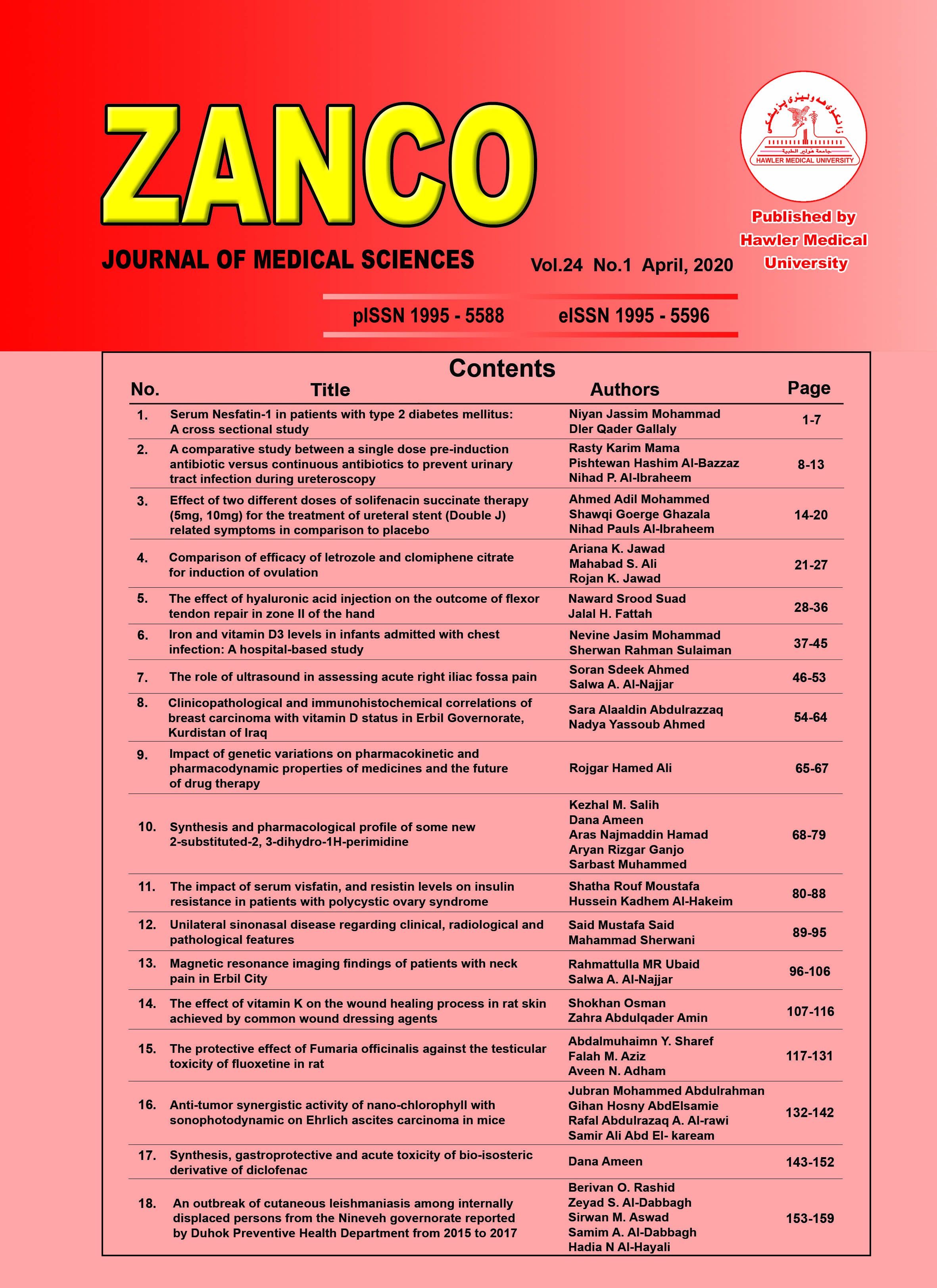An outbreak of cutaneous leishmaniasis among internally displaced persons from the Nineveh governorate reported by Duhok Preventive Health Department from 2015 to 2017
Copyright (c) 2020 Berivan O. Rashid, Zeyad S. Al-Dabbagh, Sirwan M. Aswad, Samim A. Al-Dabbagh, Hadia N Al-Hayali (Author)

This work is licensed under a Creative Commons Attribution-NonCommercial-ShareAlike 4.0 International License.
- Articles
- Submited: June 1, 2020
-
Published: April 30, 2020
Abstract
Background and objective: Cutaneous leishmaniasis is an endemic disease in Iraq, mainly in central and southern regions. The disease is, however, lower or rare in Kurdistan region of Iraq; which is situated to the north of the country. After the summer of 2014, there was a massive displacement of population to Kurdistan, mainly from the central region. The aim of this work was to investigate the outbreak reported by Duhok preventive health department among internally displaced persons from Ninewa to Duhok governorate between 2015-2017.
Methods: A cross sectional study design was conducted on the records of internally displaced persons from Nineveh governorate who were diagnosed clinically as cutaneous leishmaniasis by Duhok health authority. Information regarding age, gender, occupation, places of current residency, expected vector exposure, displacement date and status, number of lesions, and date of onset.
Results: A total of 451cases were reported during the study period. The mean age was 22.7±17.1 years, and about 69% of cases were in the age group of 5-44 years. The mean number and SD of lesions was 3.6 (±4.2), with a range of 1-35lesions. Three quarter of patients were off camps during diagnosis. Cases were mainly encountered in autumn. All, except 17, have suspected vector exposure outside Duhok governorate. No significant variation was noted regarding gender, age, occupation, urban/rural residency, and displacement status.
Conclusion: A significant outbreak has occurred in Duhok, an area not known to be endemic with the disease. Close surveillance and strict preventive measures are highly recommended.
Metrics
References
- Burza S, Croft SL, Boelaert M., Leishmaniasis, Lancet 2018; 392:951–70.
- Jacobson RL. Leishmaniasis in era of conflict in the Middle East. Vector Borne Zoonotic Dis 2011; 11(3):247–58.
- Salam N, Al-shaqha WM, Azzi A. Leishmaniasis in the Middle East: Incidence and epidemiology. PLOS Negl Trop Dis 2014; 8(10):e3208,
- World Health Organization. Communicable diseases toolkit. Iraq crisis. (Accessed November 2, 2018, at www.who.int/disease_control_emergencies/toolkits/Iraq_profile_ok.pdf).
- Duhok directorate general of health. Department of planning. Annual report, 2016, Duhok, Kurdistan region, Iraq; 2016.
- Board of Relief and humanitarian affairs (B. R.H. A). IDPs and refugees in Duhok governorate, Profile and general information. B.R.H.A-executive directorate, Duhok governorate, Feb 2016. (Accessed November 2, 2018, at www.brha-duhok.org).
- Duhok preventive health department, communicable diseases control unit, Duhok General Directorate of Health, Kurdistan Region, Iraq; 2018.
- Board of Relief and humanitarian affairs (B. R.H. A). IDPs and refugees in Duhok governorate, Profile and general information. Annual report, 2017. B.R.H.A-executive directorate, Duhok governorate, Feb 2017. www.brha-duhok.org
- Al-Warid HS, Al-Saqur IM, Al-Tuwaijari SB, Al Zadawi KAM. The distribution of cutaneous leishmaniasis in Iraq: demographic and climate aspects. Asian Biomedicine 2017; 11(3):255–60.
- WHO. Leishmaniasis. Country profile 2014. (Accessed November 2, 2018, at http://www.who.int/leishmaniasis/burden/country_profiles/en/).
- Rehman K, Walochnik J, Mischlinger J, Alassil B, Allan R, Ramharter M. Leishmaniasis in Northern Syria during Civil War. Emerg Infect Dis 2018; 24(11):1973–81.
- Afran B, Rahman S. Correlation of clinical, histopathological and microbiological finding in 60 cases of cutaneous leishmaniasis. IJDVL 2006; 72:28–32.
- AlSamarai AM, AlObadi HS. Cutaneous leishmaniasis in Iraq. J Infect Dev Ctries 2009; 3(2):123–9.
- Abdulla QB, Shabila NP, Al-Hadithi TS. An outbreak of Cutaneousleishmaniasis in Erbil governorate of Iraqi Kurdistan Region in 2015. J Infect Dev Ctries 2018; 12(8):600–7.
- Qurtas DS. Cutaneous Leishmaniasis in Erbil governorate: clinical manifestation and disease course. Med J Islam Repub Iran 2018; 32:71.
- Al-Khayat ZAY, Agha NFS, Alharmni KIF, Khudhur YJ. A clinico-epidemiological study on cutaneous leishmaniasis in Erbil, Iraq (2015-2017). Int J Res Dermatol 2018; 4(1):1–7.
- Al-Bajalan MM, Al-Jaf SM, Niranji SS, Abdulkareem R, Al-Kayali KK, Kato H. An outbreak of Leishmania major from an endemic to non-endemic region posed a public health threat in Iraq from 2014-2017: epidemiological, molecular and phylogenetic studies. PLOS/ Negl Trop Dis 2018; 12(3):e0006255.
- Service MW. Phlebotominesand-flies. In: Service M, editor. Medical entomology for students. 4th ed. Cambridge: Cambridge University Press; 2008.





